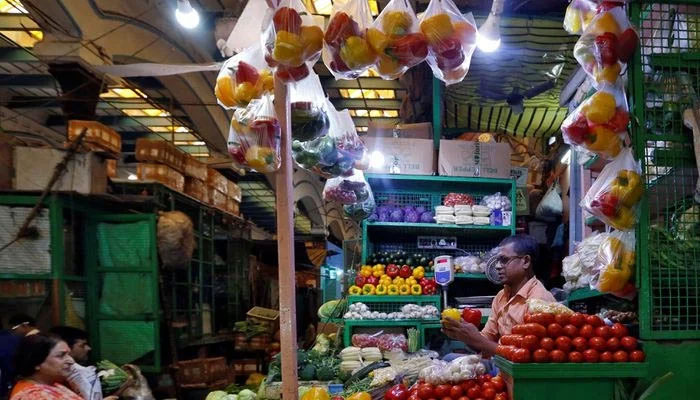From 2018 to October 2021: Pak inflation rate remained on higher side compared to regional states
ISLAMABAD: Pakistan’s inflation rate has remained on the higher side in almost four years period from 2018 to October 2021 compared to other regional countries, including India, Bangladesh and Sri Lanka.
The inflation-related data also showed that the rate of inflation was on the lower side from 2013 to 2017 compared to other regional countries. Some top officials of the government also stated that traditionally India released Wholesale Price Index (WPI) for gauging prevailing pricing trend while in Pakistan the Consumer Price Index (CPI) is used to show pricing trend. However, the Economist magazine also showed India’s CPI-based inflation to make a comparison with other regional countries. The WPI in Pakistan is also on the much higher side at the moment as WPI inflation on a YoY basis increased by 21.2 percent in October 2021 as compared to an increase of 19.6 percent a month earlier.
Pakistan’s rate of inflation stood at 5.1 percent in 2018 while it stood at 3.9 percent in India, 5.5 percent in Bangladesh, and 2.1 percent in Sri Lanka.
The rate of inflation went up to 10.6 percent in Pakistan in 2019 while it stood at 3.7 percent in India, 5.6 percent in Bangladesh and 3.5 percent in Sri Lanka.
Pakistan’s inflation rate stood at 9.7 percent in 2020 while it remained at 6.6 percent in India, 5.7 percent in Bangladesh and 6.2 percent in Sri Lanka.
Till October 2021, the rate of inflation stood at 9.2 percent in Pakistan while it was hovering around 5.3 percent in India, 5.6 percent in Bangladesh and 7.6 percent in Sri Lanka.
When contacted, the former finance minister and renowned economist Dr Hafiz A Pasha, he said that the rate of inflation was standing in the range of around 9 to 10 percent while it stood at 5 to 6 percent in other regional countries.
He said that the rampant devaluation of the rupee against the dollar, expansionary money growth, and exceeding budget deficit target played a key role in rising inflationary pressures in Pakistan. He said that there was complete mismanagement in sugar that resulted in price increase of sweeteners. He recalled that once the sugar prices escalated 25 paisa per kg during the tenure of the Ayub regime, the country witnessed massive protests which ultimately resulted in ousting him from power. But now the prices of sugar had gone up unprecedented just in a couple of days but the government was clueless about how to control the crisis.
Former economic adviser and renowned economist Dr Ashfaque Hassan Khan told The News, that comparing prices with India was just comparing apple with oranges because our currency was lower 2.33 times than India. The Indian rupee was valued at 73 to a dollar while Pakistani rupee was at 170 against dollar. He was of the view that the devaluation played a major role in rising prices in Pakistan.
In 2013, the rate of inflation stood at 7.7 percent in Pakistan while it was hovering around 11.1 percent in India, 7.5 percent in Bangladesh and 6.9 percent in Sri Lanka.
In 2014, the rate of inflation in Pakistan was 7.2 percent while in India it stood at 6.6 percent, 7 percent in Bangladesh and 3.2 percent in Sri Lanka.
The rate of inflation in Pakistan stood at 2.5 percent in 2015 while it was hovering around 4.9 percent in India, 6.2 percent in Bangladesh and 3.8 percent in Sri Lanka.
In 2016, Pakistan’s rate of inflation stood at 3.8 percent while it was ranged at 4.9 percent in India, 5.5 percent in Bangladesh and 4 percent in Sri Lanka. Similarly, the rate of inflation hovered around 4.1 percent in Pakistan in 2017 while it stood at 3.3 percent in Pakistan, 5.7 percent in Bangladesh and 7.7 percent in Sri Lanka.
-
 Zoe Saldana Overtakes Scarlett Johansson To Become Highest Grossing Actor Of All Time
Zoe Saldana Overtakes Scarlett Johansson To Become Highest Grossing Actor Of All Time -
 Former Congressional Employee Sold Stolen Government Phones For $150k
Former Congressional Employee Sold Stolen Government Phones For $150k -
 Joe Keery Credits Friends For Rare Experience
Joe Keery Credits Friends For Rare Experience -
 Jackson White Teases Darker Turn For Stephen In 'Tell Me Lies' Season 3
Jackson White Teases Darker Turn For Stephen In 'Tell Me Lies' Season 3 -
 Chris Hemsworth Leans On Matt Damon Amid His Shaky Marriage To Elsa Pataky?
Chris Hemsworth Leans On Matt Damon Amid His Shaky Marriage To Elsa Pataky? -
 Friends Of Prince William 'aghast' As King Charles Offers Olive Branch To Harry, Meghan Markle
Friends Of Prince William 'aghast' As King Charles Offers Olive Branch To Harry, Meghan Markle -
 What Cancer Does Colleen Hoover Have?
What Cancer Does Colleen Hoover Have? -
 Zayn Malik Drops Special Surprise For Fans On His 33rd Birthday
Zayn Malik Drops Special Surprise For Fans On His 33rd Birthday -
 Nicola Peltz Sends Harsh Message To Beckhams With Brooklyn Comments
Nicola Peltz Sends Harsh Message To Beckhams With Brooklyn Comments -
 Apple Martin 'lashes' Out At Mom Gwyneth Paltrow For Pushing Her 'too Hard'
Apple Martin 'lashes' Out At Mom Gwyneth Paltrow For Pushing Her 'too Hard' -
 Meghan Markle Going To 'humiliate' Prince Harry With UK Trip
Meghan Markle Going To 'humiliate' Prince Harry With UK Trip -
 Pastor Jailed After Secretly Filming Woman In Store
Pastor Jailed After Secretly Filming Woman In Store -
 Julio Iglesias Faces Serious Abuse Accusation
Julio Iglesias Faces Serious Abuse Accusation -
 Buckingham Palace’s ‘liability’ Prince Harry Comes Under Fire: ‘Can Really Harm King Charles’
Buckingham Palace’s ‘liability’ Prince Harry Comes Under Fire: ‘Can Really Harm King Charles’ -
 Emily Bader Reveals Inspiration Behind Choosing Latest Project
Emily Bader Reveals Inspiration Behind Choosing Latest Project -
 Anthropic Rolls Out Claude Cowork For Non-coders
Anthropic Rolls Out Claude Cowork For Non-coders




